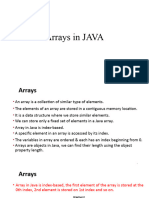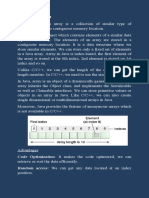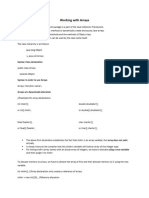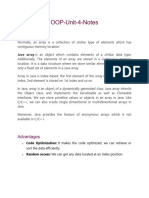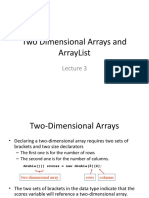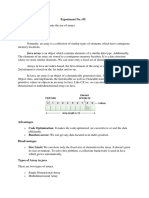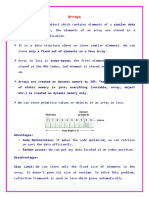Unit-II
Arrays
• Related data item stored in common name is called array.
• Array of primitive
• int[] numbers = {1, 2, 3, 4, 5}; // Array of primitive int values
• char[] letters = {'a', 'b', 'c'}; // Array of primitive char values
• Array of non-primitive
• String[] names = {"Alice", "Bob", "Charlie"}; // Array of String objects
(references)
• Integer[] scores = new Integer[3]; // Array of Integer objects
(references) scores[0] = 100;
�Arrays
� One dimensional Arrays
• // Declaration
• int[] numbers;
• // Declaration and initialization with a specific size
• int[] ages = new int[5]; // An array of 5 integers
• // Declaration and initialization with values
• String[] names = {"Alice", "Bob", "Charlie"};
� One dimensional Arrays
• public class onedimen {
• public static void main(String[] args) {
• // initializing array
• int[] arr = { 40,55,63,17,22,68,89,97,89};
• // size of array
• int n = arr.length;
• // traversing array
• for (int i = 0; i < n; i++)
• System.out.print(arr[i] + " ");
• }}
• Out put
• 40 55 63 17 22 68 89 97 89
� Dimensional Arrays
• Examples:
• // Two dimensional array:
• int[][] arr2d = new int[3][5];
• // Three dimensional array:
• int[][][] arr3d = new int[3][5][7];
� Two dimensional Arrays
• // Java Program to demonstrate the use of
• // Two Dimensional Array
• import java.io.*;
• class Main {
• public static void main(String[] args){
• // Array Intialised and Assigned
• int[][] arr = { { 1, 2 }, { 3, 4 } };
• // Printing the Array
• for (int i = 0; i < 2; i++){
• for (int j = 0; j < 2; j++)
• System.out.print(arr[i][j]+" ");
• System.out.println();
• }
• }
• }
• OUT PUT
12
34





